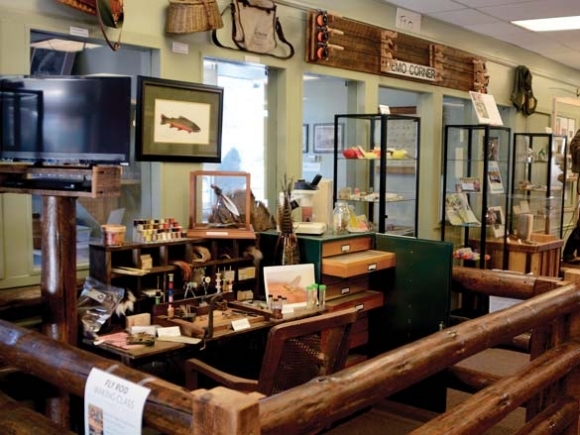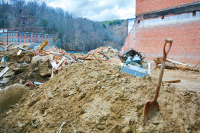Bryson gets fishy: Fly-fishing museum prepares for expansion

In its two years of existence, the Fly Fishing Museum of the Southern Appalachians has shown a willingness to travel.
First, from the mind of fly fishing enthusiast Alen Baker to the wood-paneled space of the Cherokee Chamber of Commerce. Then to the sunny Swain County Chamber of Commerce building in downtown Bryson City. And, soon, to a new building on Bryson City’s Island Street, just across the road from the trout-stocked waters of the Tuckasegee River.
To be clear, the existing museum exhibits will remain at the Chamber of Commerce. But the new building will house aquariums and learning centers in addition to new exhibits that take the experience to a whole new level.
“It doubles the capacity of the museum,” Baker said.
The expansion will allow the museum to do what Baker had dreamed it would since he first conceptualized the project in 2012 and opened its doors in Cherokee in 2015.
“When we were in Cherokee, from day one the vision was that we would have aquariums as part of the museum,” he said. “Part of the reason being that people need to see the fish you can go fly fishing for in the Southern Appalachians.”
Related Items
There was even a room set aside to one day house the aquariums in Cherokee, but when the tribal government abruptly decided to cancel the lease that allowed the Cherokee Chamber of Commerce — and, by extension, the fly fishing museum — to occupy the space, the fly-fishing museum moved next door to Bryson City, where it was welcomed into the Swain County Chamber of Commerce building. However, that location has no space for aquariums.
Now, county government and the Swain County Tourism Development Authority are teaming up to give the fly-fishing museum the space it’s been dreaming of. The 1,000-square-foot building is currently under construction a stone’s throw from the heritage barn on Island Drive, where the Swain County Farmers Market is held during the warmer months. Walls are up with a roof soon to come — Baker hopes to hold a soft opening in June, to align with the date that the museum originally opened in Cherokee in 2015, but it’s possible the museum won’t be ready until later in the summer.
Regardless of the exact opening date, Swain County Chamber of Commerce Director Karen Wilmot is excited about the upcoming expansion.
“We are looking forward to the next phase of the fly fishing museum expansion with the aquarium and learning center opening next year,” Wilmot said. “Swain County, with its miles of streams, rivers and lakes, is the perfect location for the museum and aquarium, and these projects are a wonderful example of how well partnerships can work with private, public and governmental entities.”
Baker’s hopes are high. There’s currently an expert working on designs for an aquarium system that will feature about five tanks of 300 gallons or more, five smaller tanks of 125-200 gallons and an indoor stream flowing through three smaller tanks, home to all kinds of trout. However, trout won’t be the only native fish swimming through the aquariums. The museum will also display musky, sunfish, bass, sicklefin redhorse, and possibly even a hellbender salamander.
“We’re not talking about exotic species like tropical fish or anything,” Baker said. “We’re talking about species of the Southern Appalachians that are pretty much available to us.”
Even so, many people who live in or often visit the area have never seen a live trout or a mess of sunfish. The museum will soon make those experiences easier to come by, and the trout filling the tanks will be the same trout that swim in the river just outside the museum. The museum board has been collaborating with the N.C. Wildlife Resources Commission and the Tennessee Wildlife Resources Agency to secure the permits necessary to collect and release fish in the wild.
Learning will be a heavy emphasis for the new space, which will include a classroom with wireless internet and a regional center for Trout in the Classroom. A program of Trout Unlimited, Trout in the Classroom allows teachers to obtain trout eggs from the state fish hatchery and raise them into small fish over the course of the school year, involving students in the experience throughout the way.
The program teaches aquatic ecology, fish life cycles, water chemistry, math skills and more, but it requires commitment from already overworked teachers and money to get the setup going. The center to be housed at the expanded fly fishing museum will help teachers successfully manage these projects, and Baker also hopes to provide small grants for teachers wanting to participate.
“That’s a struggle in all schools, to find the money to set it up,” he said. “We’ll do that one way or another. We may have loaner equipment or we’ll do grants to help them buy equipment.”
None of this — the building, the aquariums, staff to run them — comes free, but the community of Swain County and Bryson City has wrapped its arms around the Fly Fishing Museum of the Southern Appalachians, with multiple entities coming together to ensure its success.
Overall, the expansion is expected to cost about $100,000, with Swain County government covering the construction and maintenance of the building, about $20,000 to $25,000. They’re looking for grants to cover as much of that as possible, said Economic Development Director Ken Mills, but will cover it one way or another. It’s hard to argue with the fact that the museum will be nothing but good for Bryson City, Mills said.
“The best phrase is it’s value added,” Mills said. “If we already have people wanting to come here and coming here, if we can increase a good experience, that’s good. On this one we cover a lot of bases. We’re covering science, we’re covering nature, people understanding what it takes to live in a balance. There’s a lot going for that.”
The remainder of the funds will come from the Swain County TDA, with Baker and the rest of the museum board working to raise some of the money from donations and fundraising events. Due to increased operational cost at the new building, the museum will begin charging a small admission fee as well, likely $5 or less. TDA money comes from a tax visitors pay when they book a hotel room in the county, so the idea is that if the museum causes more people to travel to Bryson City or entices those already planning trips to extend their stay, the investment could eventually pay for itself.
“I don’t really see things going anywhere but better,” Baker said, “because with the new building there will be probably more interest in the aquariums than in some cases the museum items.”

Fish sculptures have arrived
Bryson City is making its fish-friendliness known with the installation of three fiberglass fish sculptures throughout town.
Located in front of the Swain County Chamber of Commerce building, at the town square and by the railroad depot, these jumping trout are brightly painted to represent the fish species swimming through Western North Carolina streams — brook, brown and rainbow trout.
The sculptures cost $6,000, including painting and installation, and were paid for by the Swain County Tourism Development Authority using a $1,200 donation from the Tuckaseegee Fly Shop. The sculptures were bought from Minnesota-based Fiber Stock and painted by Ed Ciociolla and Phil Watford. Plaques identifying the type of fish and offering a brief description of the species will be installed this week.
Donate to the cause
The Fly Fishing Museum of the Southern Appalachians relies on donations and volunteer support to run, and with the upcoming expansion those contributions will be more vital than ever before.
Information about becoming a member of the museum or making a donation is available at www.flyfishingmuseum.org/join.html.
828.488.3681 or This email address is being protected from spambots. You need JavaScript enabled to view it..









